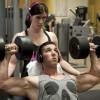CYBERMED LIFE - ORGANIC & NATURAL LIVING
CYBERMED LIFE - ORGANIC & NATURAL LIVING
 Resistance Training: Strength training is a type of physical exercise specializing in the use of resistance to induce muscular contraction which builds the strength, anaerobic endurance, and size of skeletal muscles.
Resistance Training: Strength training is a type of physical exercise specializing in the use of resistance to induce muscular contraction which builds the strength, anaerobic endurance, and size of skeletal muscles.
When properly performed, strength training can provide significant functional benefits and improvement in overall health and well-being, including increased bone, muscle, tendon, and ligament strength and toughness, improved joint function, reduced potential for injury, increased bone density, increased metabolism, increased fitness and improved cardiac function. Training commonly uses the technique of progressively increasing the force output of the muscle through incremental weight increases and uses a variety of exercises and types of equipment to target specific muscle groups. Strength training is primarily an anaerobic activity, although some proponents have adapted it to provide the benefits of aerobic exercise through circuit training.
Strength training is typically associated with the production of lactate, which is a limiting factor of exercise performance. Regular endurance exercise leads to adaptations in skeletal muscle which can prevent lactate levels from rising during strength training. This is mediated via activation of PGC-1alpha which alter the LDH (lactate dehydrogenase) isoenzyme complex composition and decreases the activity of the lactate generating enzyme LDHA, while increasing the activity of the lactate metabolizing enzyme LDHB.
Sports where strength training is central are bodybuilding, weightlifting, powerlifting, strongman, Highland games, shotput, discus throw, and javelin throw. Many other sports use strength training as part of their training regimen, notably tennis, American football, wrestling, track and field, rowing, lacrosse, basketball, pole dancing, hockey, professional wrestling, rugby union, rugby league, and soccer. Strength training for other sports and physical activities is becoming increasingly popular.